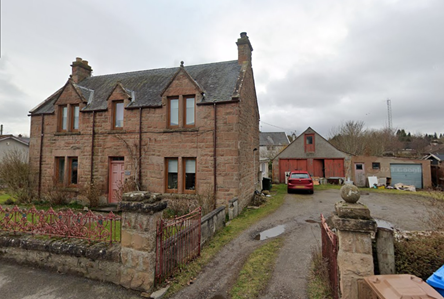Great North Road
Attribution: unknown or not recorded
Great North Road - Muir of Ord High Street
Many of the buildings are known by the bynames of previous owners or tenants. The following page will identify each building to make identification easier in the future and also provide some information on the people that lived there.
Commercial properties will appear on our Commercial pages, in due course.
Robertson Building
Pictured in the left hand photograph, above.
Mrs Fraser of Tarradale Hotel owned this building prior to 1899 when Alexander Robertson bought it from her, he had been leasing the property since 1896.
Alexander was a farmer’s son from Cortachy, Forfarshire and continued working in farming when he was recorded as an Agricultural labourer on the 1871 census, having married Margaret Ogilvie in 1869.
By 1881, he was working as a Gamekeeper at Ridorach, Glenshee and ten years later he was still a gamekeeper but now living in Applecross.
The couple had fifteen children.
Alexander Robertson died in 1910 and his wife in 1915.
The executors of Alexander’s estate were his son David and son-in-law, Alexander Maclean.Robertson Buildings is a tenement building and as well as the Robertson family, Alexander leased out rooms to several others.
Another son, Collinson continued to live in the property until his death in 1947, however at some point the building was sold to the Forbes family with John Forbes of Bridgemount being the named owner on the 1925 and 1930 valuation rolls. The 1935 valuation roll has John’s sisters, Anita and Margaret as the named owners.
Mackintosh Buildings
Brothers William and Andrew Mackintosh of Milton of Redcastle were the lessees of this property from around 1865, where they were known to have their joiner’s premises. Their father, Andrew had also been a Carpenter and most probably built the property at Milton of Redcastle.
On the 1874 Valuation Roll, the building was home to four families with Andrew and William having the shop that is now Blythswood Charity shop. There was also known to have been a workshop and yard behind the building.
William was married in 1885 to Williamina Watson of Whitehills in 1885 and by 1905 he was living at Sunnybank, Munlochy. When William and Andrew took over the business from their father, it was reported that the business prospered. Both brothers were well respected throughout Inverness, Dingwall and the Black Isle. William continued to work until shortly before his death in 1911, aged 78 years.
A news report of 1896 saw five tenants being prosecuted under the public health act for inappropriate depositing of “decaying animal and vegetable putrescent matter”. They were ordered to sop this practice, clean the area and found liable for the court expenses which was reduced to a fine of five shillings each.
The Manson family
The Manson family appear to have lived in and around the local area for several years with Charles Manson, father, being a farm hand/ploughman on various farms at Kiltarlity, Drumnadrochit, Knockbain, Urray and Contin.
The family first appear in the Urray area at Bellvue farm on the 1891 census. Sadly, there was no mother recorded and on further searches she had died in the same year, before the census was taken, leaving Charles with seven children aged 3 to 16.
By the 1901 census, Charles was recorded as a pauper which could indicate he had been injured or was in poor health and had lost his job. Only three of his children were living with him at MacIntosh Building, with only 1 of them in employment.
The 1911 census records Charles as a retired ploughman and the same three children were still living at home with him. James aged 25 was a domestic groom, Christina, aged 30 was a dressmaker and Catherine aged 23, had no recorded employment.
Son James was killed in action during WW1 and both Christina and Catherine remained at home.
Charles snr. died in 1922 and the valuation roll indicates a Charles Manson jnr, Engine Driver was recorded as the tenant although it is entirely possible that Christina and Catherine lived there too.
Christina died in 1935, following a long illness.
As a well-respected member of the local community, her obituary was published in the Aberdeen Press and Journal, indicating her participations in various activities in the village. She was always ready to help at any function, especially in the cause of charity. She organised the teas for the men’s club, was a useful member of the S.W.R.I., a playing member of the golf club and a devoted member of the Urray West Church Choir.
Vulcan Cottage
Once the home of the Urquhart family. This was one of the local blacksmith’s.
A nephew, Johnny ‘Boggan’ Uraquhart, mentions it in his memoires.
Mackenzie & Logan's Building
Mackenzie to the right, Logan’s Building to the left.
MacLennan & Forbes Buildings
A map created by Jock Chisolm -‘ Village Life in the 1930’s’, has this building recorded as:
Forbes to the right and MacLennan to the left (Cafe & cake shop). However, the Cake shop was previously the Forbes cafe as the Forbes family boughtb most of the properties on this street at one time.
It is my belief that the Maclennan family were once associated with this building and Forbes took ownership of the left side building at a later date.
Attribution: not recorded or unknown
McDonald Family of Forbes Building
The family had lived in the village from around 1897. This photo was taken around 1910, possibly to send to Alexander who had emigrated to Australia.
Pictured are: Elizabeth Ann, Hugh, James D, Jessie, Margaret,
Johan, John, James
In 1911, John was a general labourer for the County Council along with his son Hugh. James D. was a local postman. Hugh was killed during WW1. (Follow link below)
By the 1921 Census, James, Johanna and their son John were living at MacKay’s building. James was now working as a labourer for J. Tuach, mason and young John was a porter for the Highland railway Company.
Derby Cottage
It is not certain when Derby cottage was built, but amongst it’s first inhabitants were the Gordon family.
Thomas and Jessie were married at Culbokie in 1906 and by the 1911 census they were living in the village.
Valuation rolls from 1915 to 1925, state that the place where they were tenants, was owned by Roderick Maclennan, who was living in the MacLennan Building on the 1921 census.
Jessie Gordon
Jessie was widowed in 1929, following a work accident, where her Traction Engine Driver husband sustained a fractured spine.
She was left to bring up their eight children on her own. They were aged between 3 and 26 years old.
Of their eight children, five of them remained in Muir of Ord.
A son worked for John MacDonald, Timber merchant and a daughter became very proactive on the Gala committee.
Jessie and her daughters were all heavily involved in the local Scottish Women’s Rural Institute, an involvement that lasted three generations, including daughters- in -law, when they joined the family.
Some of Thomas and Jessie’s great grandchildren still live in the village today.
MacKay Building - Ivy Cottage
It is believed the first family to live at this property were Alexander Mackay and his wife Annie MacDonald. Alexander was the son of John Mackay, a farmer at Lower Arcan. He married Annie in the Urray Parish in 1875 and had two children:
Helen Catherine was born at Urray in 1877. The 1901 census has her working as a kitchen maid at the Royal Hotel in Bridge of Allan. She married John Scott and died in 1916 at Germiston, Transvaal, South Africa. Her daughter Joan MacKay Scott was born in 1916 so it is entirely possible Catherine died in childbirth. In researching the surname Scott, there appear to have been a large family based in Germiston, who were heavily involved in the mining business.
Roderick was born at Urray in 1878. He served with the Australian Infantry during WW1 and died from wounds received in action on 18th April 1918. He is buried at the Ebblinghem Military Cemetery, Nord-Pas-de-Calais, France. His death record names his wife as Margaret. At the time of his death she was living in Edinburgh, however at the time of his internment her address was Melbourne, Australia.
Ivy Cottage
Although the house was recorded as Mackay’s Building on the 1921 Valuation Roll, it was also referred to as Ivy Cottage on the death notice of Annie in 1911 and Alexander in 1919. It appears the only living descendant at that time was Helen’s daughter Joan, who remained in South Africa.
There are also indications that part of the building was tenanted as another casualty of WW1, Alexander Mackintosh (1st 4th Seaforths) was recorded as being the son of Mrs Mackintosh, Ivy Cottage in 1915.
By 1925 the owner of the building was recorded as wood merchant, John Finlay.
The building was put up for sale in 1967, where it was described as consisting of three houses which were to be sold separately.
Ground Floor Flat of two rooms, kitchen and bathroom.
First Floor Flat of a similar size. House comprising on ground floor, two public rooms and kitchen; on first floor, three bedrooms and bathroom; front garden.
All houses had been fully modernised with kitchens equipped with electric cooker and immersion heaters.
There was also ample space for garages to the rear.
Like any other older house, there were several more deaths associated with it but are mostly too recent to name for privacy reasons although they did all manage to live to nearly 100 years old.
Heatherlea
Once home to the Logan family, a local engineer and employer.
Made famous by son, William of Loganair and builder of many hydro electric schemes in the area and bridges in Scotland.
Read his story below:
Dunellan
Dunellan was built around 1893 for Duncan Cameron, its architect being Mr MacKenzie of Inverness. The house does not appear as Dunellan until the 1901 census, by which time he had married Helen Forbes, daughter of John Forbes of Bridgemount, across the road. The unique name of Dunellan being an amalgamation of the couple’s first names. The couple had married in the summer of 1900 at St Pancras, London.
Duncan died in 1938, eight years after his wife and on the 1940 valuation roll their daughter, Helen Cameron was the named proprietor. Helen was married that same year and she and her husband were living at Caberfeidh by 1941.
Duncan bequeathed substantial amounts of money to the Inverness Royal Northern Infirmary, Ross memorial Hospital and the East and West Nursing Associations. He also left money to the Sunday schools of the East Urray Church and Urray Free Church to purchase prizes for boys and girls ‘most learned in the Shorter Catechism’. The examination of school children in the Shorter Catechism stopped in the early 1960’s.
Following the retiral of Duncan Murdo, the shop and house were transferred to the Moir family and the shop closed in the late 1980’s.
















